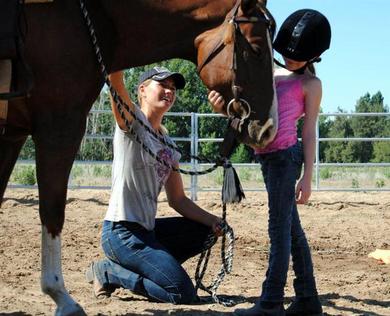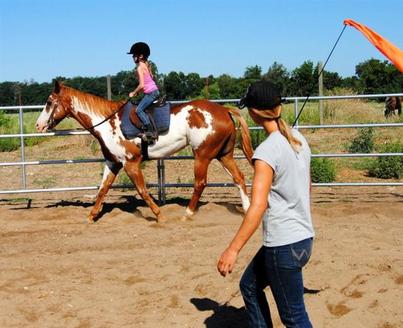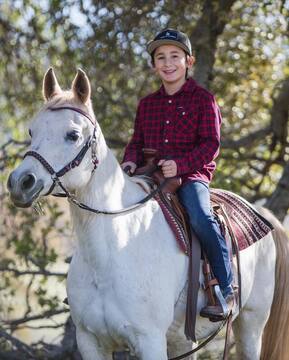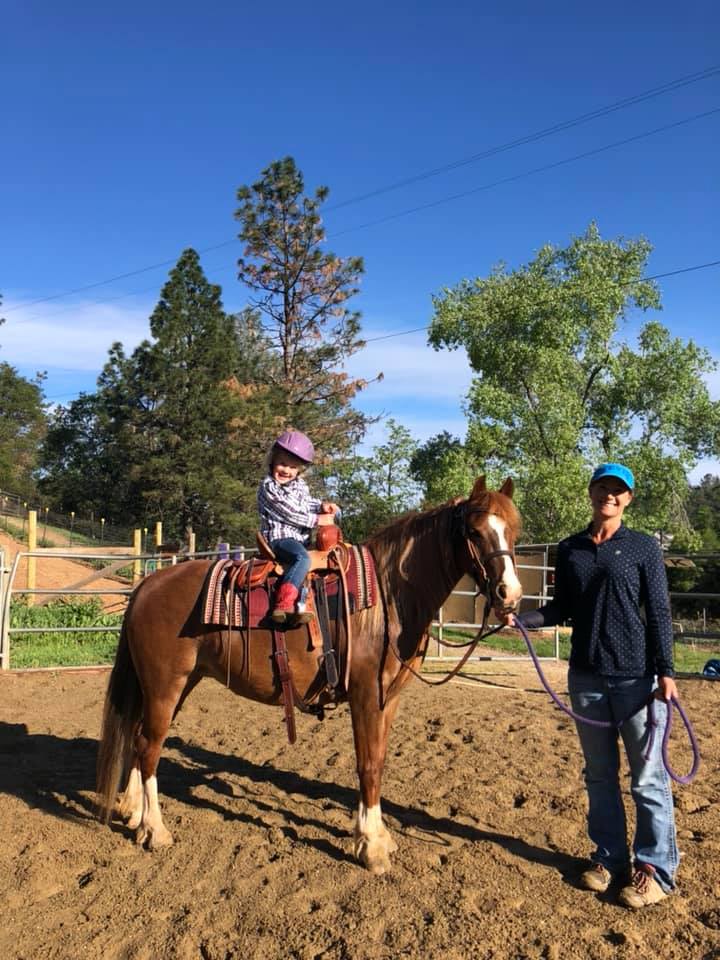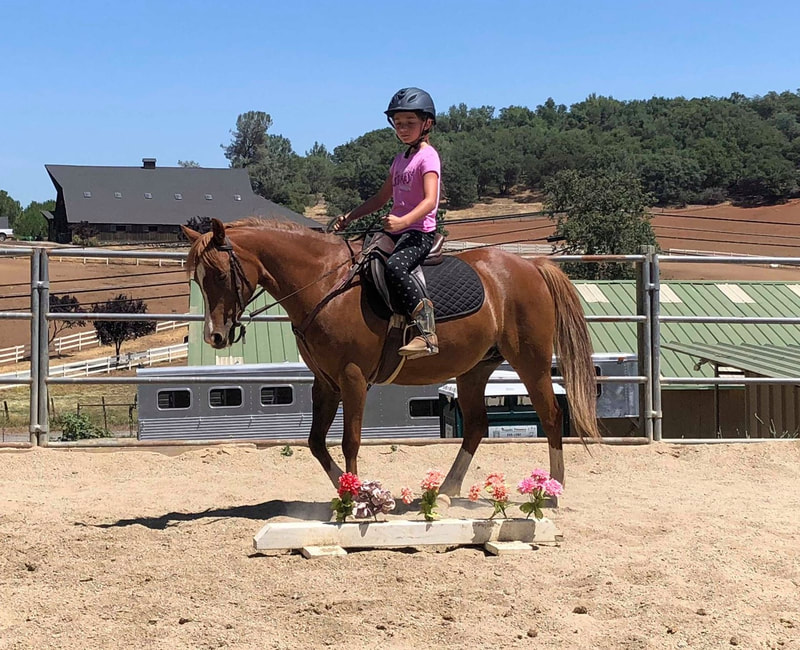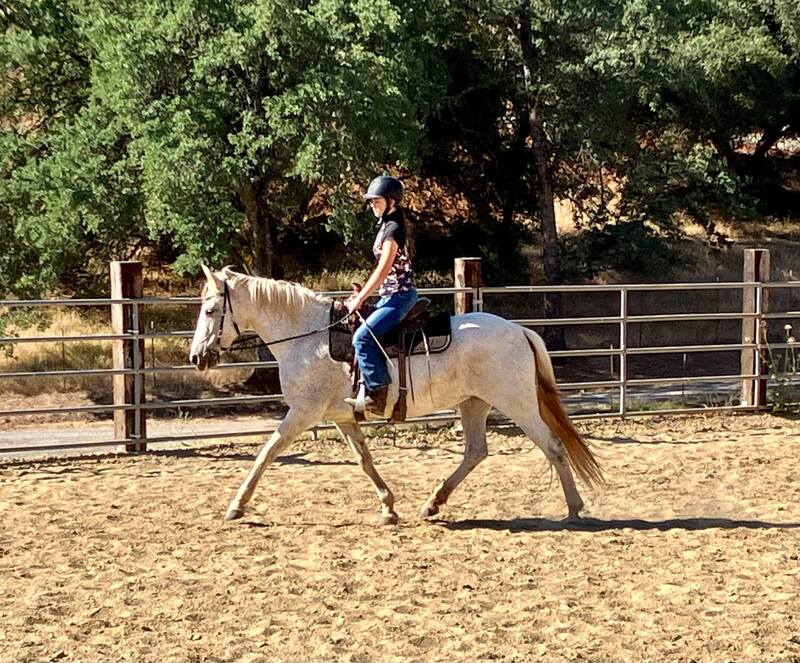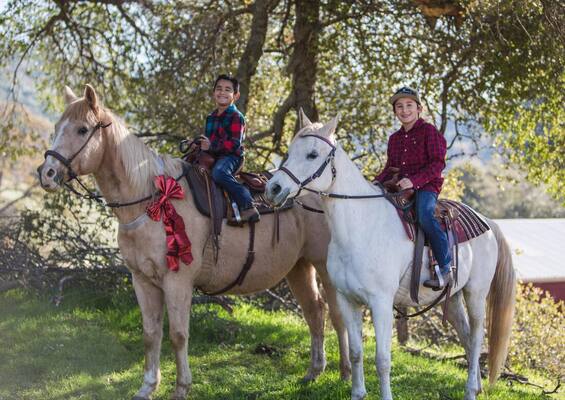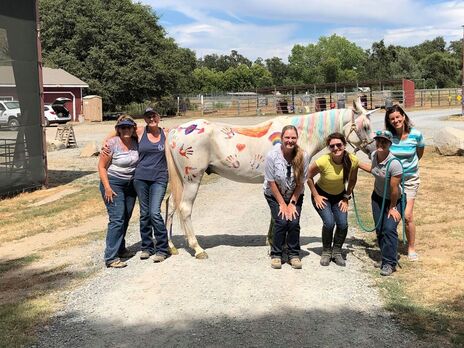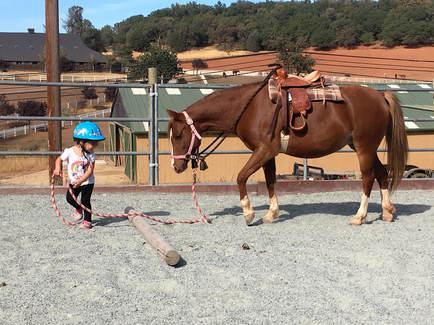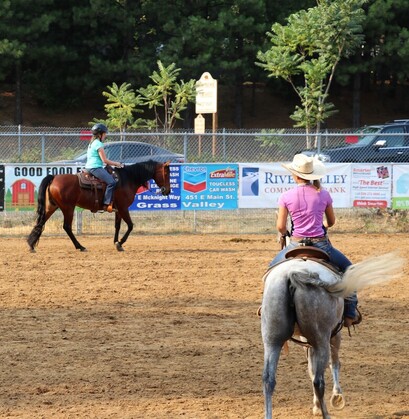Riding Lessons
** EXCITING NEWS**
The lesson program is on its way to expanding! Lesson horses are being added. Emphasis on instruction for dedicated riders with an interest to learn and compete. Look for updates on instruction, seminars, clinics, and mini clinics! Youth and adult riders welcome!
PLEASE NOTE: PRICE ADJUSTMENTS FORCASTED FOR APRIL 2023
The lesson program is on its way to expanding! Lesson horses are being added. Emphasis on instruction for dedicated riders with an interest to learn and compete. Look for updates on instruction, seminars, clinics, and mini clinics! Youth and adult riders welcome!
PLEASE NOTE: PRICE ADJUSTMENTS FORCASTED FOR APRIL 2023
_The horse knows how to be a horse if we will leave him alone... but the riders don't know how to ride. What we should be doing is creating riders and that takes care of the horse immediately. ~ Charles de Kunffy
Lessons are taught through improving the riders balance paired with learning the breakdown of commands to give to your horse. Riders are taught at their own pace with their own rider goals in mind. Grasp concepts about body position and movement, while learning to identify the signs that your horse is working towards working in a pleasant, physically correct position.
All ages and disciplines welcome!
_
Riders are taught:
Riders are taught:
- Groundwork-How to do it and what it means to your horse
- Safe and effective horsemanship skills for the arena and trail riding
- Creating a successful partnership for the show ring
- Biomechanics - form and function
- Horse behavior and communication
- Equitation - how rider position to create clear cues
- Show skills and strategy
Lesson Pricing
See "Documents" for Price Sheet
24 hour cancellation notice required to avoid cancellation fee.
**NEW**
Ask about half leasing your favorite lesson horse!
Set yourself up for a successful lesson:
- Arrive early - for riders that don't need help with tacking up, get your horse ready ahead of time, so you are ready to go on time.
- Remember your gear - Do you need a helmet or spurs or anything else you need to remember to pack?
- Do your homework - to make the most of your lessons, practice between lessons! This could mean working with your horse, or doing unmounted stretches or balance exercises in the comfort of your home. Centered Riding books are great references for unmounted exercises.
- Make goals to measure success.
- Riding involves a lot of body control. Strenthening exercises and stretching will help you improve at a more rapid rate.
- Watch other riders in lessons, clinics, or online. See how what you are doing ties in to the big picture. Compare and contrast what you are doing with how other riders are getting it done. Find language that helps the ideas you are learning resonate for a more rapid progression.
- Don't forget to have fun! There may be bumps in the road, but enjoy the journey. It is worth it!
GROUP INSTRUCTION NOW AVAILABLE
Group lessons available! Days and times subject to change with the seasons.
Intermediate riders, Saturday 10am-12pm.
Please inquire about other group sessions and availability.
RSVP REQUIRED!
Intermediate riders, Saturday 10am-12pm.
Please inquire about other group sessions and availability.
RSVP REQUIRED!
Meet our Lesson Horses!
Al-Marah Cool Star
AM Goodolboy x AM Precious Dream
2006 Arabian Mare
Cool Star came to us in 2020 from A Wing and a Prayer Fine Horses in Arizona. Her background was in cutting and they owned a half sister to "Cool" that was a national champion cutting mare. Her usability was what made her a prime candidate to join the program and she has been a perfect fit ever since. Cool is a favorite of riders with her uncomplicated attitude and smooth way of traveling.
AM Goodolboy x AM Precious Dream
2006 Arabian Mare
Cool Star came to us in 2020 from A Wing and a Prayer Fine Horses in Arizona. Her background was in cutting and they owned a half sister to "Cool" that was a national champion cutting mare. Her usability was what made her a prime candidate to join the program and she has been a perfect fit ever since. Cool is a favorite of riders with her uncomplicated attitude and smooth way of traveling.
Evans Corinith
Evans Providence of the night x Priestwood Porcelain
2011 Welsh pony mare
Everyone loves the cutest little pony in the barn! This is our little 12.3hh princess. She is full of personality, loves the littles, but has a motor when you need it. Welsh ponies are bred mostly as english mounts, but Cora has been a gymkana pony as well. As long as she is getting attention she is happy to do whatever we ask of her.
Evans Providence of the night x Priestwood Porcelain
2011 Welsh pony mare
Everyone loves the cutest little pony in the barn! This is our little 12.3hh princess. She is full of personality, loves the littles, but has a motor when you need it. Welsh ponies are bred mostly as english mounts, but Cora has been a gymkana pony as well. As long as she is getting attention she is happy to do whatever we ask of her.
"Sparrow"
2009 Andalusian Mare
For those that like feeling like you are on a movie set, meet "Sparrow!" She has the signature movement of the Iberian breeds that you see in the movies, as well as being smooth. She is quick to learn and please. In her former life she was a broodmare and was started under saddle in winter of 2022 by the Wild Heart Ranch Vaulters in Lincoln.
2009 Andalusian Mare
For those that like feeling like you are on a movie set, meet "Sparrow!" She has the signature movement of the Iberian breeds that you see in the movies, as well as being smooth. She is quick to learn and please. In her former life she was a broodmare and was started under saddle in winter of 2022 by the Wild Heart Ranch Vaulters in Lincoln.
Equestrian Speed of Education
How often should you ride or take lessons? Well, that depends... What are your goals and how fast do you want to learn them? Equestrian education also depends on the fitness and psychological retention of the rider, as well as if they are going home and practicing the materials. Practicing may mean unmounted study, like working on form with a balance ball or reading articles and watching YouTube videos. Having a horse to ride between lessons is also very helpful, whether that means an owned horse or leased horse. The more time a person dedicates to anything, the better they understand the material and the faster they learn it.
The standard riding lesson is once a week. What do we get out of once a week? At this pace, there is some regularity to retain information. Once a week allows riders to chip away at new skills and have some retention. Each week a rider should hope to add one to three new pieces to the puzzle to improve their skill set. One new piece may mean holding the hands a little lower, improving the release point, increasing fitness level, or learning a new pattern. A rider may learn more than one thing in a lesson, but over the years of riding, studying, and teaching, one to three new key concepts per lesson seems like a very realistic goal. It is up to the rider to identify what they need to improve and hang on to that piece of information to incorporate to future lessons.
Riders that want to increase their retention may take lessons 2-3 times a week. For someone that really wants to knock out bad habits or improve at a more rapid rate, this is the way to go. If you want to prep for a horse show and feel really confident, you may take this route heading into competition time. The more time you are watched under saddle, the less time you have the opportunity to fall into bad habits. Imagine, a rider learns one new component a week for a month, four new skills. Another rider increases their retention, takes two lessons a week for a month and has eight or more new skills!
Sometimes a person only has the capacity to take periodic lessons. For non-horse owners, it's a starting point to get you out there. The trouble is, it can feel like starting over each lesson when you are lacking regularity. The capacity to increase your skill set is limited and needs to be supplemented by at home unmounted study to really retain the information at hand. For someone with at home access to a horse, irregular lessons can get you out of a rut that you may be in, but you can only learn so much in each single session. It helps to do a few sessions in a row to get out of your rut and back on the main road of where you wanted to be.
Education is an endless road that spans as long as you want to go. If the human species is expected to be more intelligent than the equine species, it is our duty to understand how to learn their language to be effective riders and handlers. Horses won't be learning English any time soon, but we can learn the art of body language, balance, movement, and release!
How often should you ride or take lessons? Well, that depends... What are your goals and how fast do you want to learn them? Equestrian education also depends on the fitness and psychological retention of the rider, as well as if they are going home and practicing the materials. Practicing may mean unmounted study, like working on form with a balance ball or reading articles and watching YouTube videos. Having a horse to ride between lessons is also very helpful, whether that means an owned horse or leased horse. The more time a person dedicates to anything, the better they understand the material and the faster they learn it.
The standard riding lesson is once a week. What do we get out of once a week? At this pace, there is some regularity to retain information. Once a week allows riders to chip away at new skills and have some retention. Each week a rider should hope to add one to three new pieces to the puzzle to improve their skill set. One new piece may mean holding the hands a little lower, improving the release point, increasing fitness level, or learning a new pattern. A rider may learn more than one thing in a lesson, but over the years of riding, studying, and teaching, one to three new key concepts per lesson seems like a very realistic goal. It is up to the rider to identify what they need to improve and hang on to that piece of information to incorporate to future lessons.
Riders that want to increase their retention may take lessons 2-3 times a week. For someone that really wants to knock out bad habits or improve at a more rapid rate, this is the way to go. If you want to prep for a horse show and feel really confident, you may take this route heading into competition time. The more time you are watched under saddle, the less time you have the opportunity to fall into bad habits. Imagine, a rider learns one new component a week for a month, four new skills. Another rider increases their retention, takes two lessons a week for a month and has eight or more new skills!
Sometimes a person only has the capacity to take periodic lessons. For non-horse owners, it's a starting point to get you out there. The trouble is, it can feel like starting over each lesson when you are lacking regularity. The capacity to increase your skill set is limited and needs to be supplemented by at home unmounted study to really retain the information at hand. For someone with at home access to a horse, irregular lessons can get you out of a rut that you may be in, but you can only learn so much in each single session. It helps to do a few sessions in a row to get out of your rut and back on the main road of where you wanted to be.
Education is an endless road that spans as long as you want to go. If the human species is expected to be more intelligent than the equine species, it is our duty to understand how to learn their language to be effective riders and handlers. Horses won't be learning English any time soon, but we can learn the art of body language, balance, movement, and release!
Why Riding lessons?
Riding lessons are the ideal way to get into horses. This allows individuals to gain experience before making the commitment of ownership. Lessons are more than just learning how to sit on a horse. Equestrians can expand on their skill set and learn valuable tools, gain hands on experience with what equipment works for them, how to identify if there is something “off” with their horse, what to do when the horse is emotional, and how to stay objective when the horse doesn’t want to listen. After the end of your session, you can go home and not have to worry about running outside in the weather to feed the horses dinner, vet bills and all the other complexities of ownership!
For some of us, just riding in a lesson setting is not satisfying enough. The next step is exploring lease options. This allows a rider to have the feeling of owning a horse, without the long term commitment. Some horses do have lease to purchase options, for those that are interested in try before you buy. A lease is ideal for a young rider that may quickly outgrow the skill set of the lease horse once they get comfortable. It’s a great way for parents to check the dedication of their child before making a commitment to ownership. A lease is also ideal for an adult that wants something to do during the fair weather months without the commitment of maintaining a horse in the winter months. Leases are typically best paired with a lesson program to preserve the skill set of the horse while they are being handled by a potentially less skilled individual than their normal owner.
By the time a rider purchases a horse, they need to be ready for the price tag of $5,000-$10,000 for a nice, average horse. Show horses can be more costly. Pre-purchase exams cost a few hundred dollars or maybe more depending on the depth of the exam. If you keep the horse at home, you need to be ready with living space, a horse trailer, truck, and a place to ride. If you board, you will need to plan for somewhere around $500/month for board. Don’t forget the veterinarian and farrier costs, saddles and gear. By the time you’ve gotten in this deep you’re committed! It can be a magical ride if you are prepared. However, dipping your toes into the water before you dive right in can be the best way to protect your investment.
We are here to help! Allow Sandy and the team to be your support system and enter this equestrian world with a network that can help. Put our years of experience to work for you to keep horses a happy, successful part of your life!
Riding lessons are the ideal way to get into horses. This allows individuals to gain experience before making the commitment of ownership. Lessons are more than just learning how to sit on a horse. Equestrians can expand on their skill set and learn valuable tools, gain hands on experience with what equipment works for them, how to identify if there is something “off” with their horse, what to do when the horse is emotional, and how to stay objective when the horse doesn’t want to listen. After the end of your session, you can go home and not have to worry about running outside in the weather to feed the horses dinner, vet bills and all the other complexities of ownership!
For some of us, just riding in a lesson setting is not satisfying enough. The next step is exploring lease options. This allows a rider to have the feeling of owning a horse, without the long term commitment. Some horses do have lease to purchase options, for those that are interested in try before you buy. A lease is ideal for a young rider that may quickly outgrow the skill set of the lease horse once they get comfortable. It’s a great way for parents to check the dedication of their child before making a commitment to ownership. A lease is also ideal for an adult that wants something to do during the fair weather months without the commitment of maintaining a horse in the winter months. Leases are typically best paired with a lesson program to preserve the skill set of the horse while they are being handled by a potentially less skilled individual than their normal owner.
By the time a rider purchases a horse, they need to be ready for the price tag of $5,000-$10,000 for a nice, average horse. Show horses can be more costly. Pre-purchase exams cost a few hundred dollars or maybe more depending on the depth of the exam. If you keep the horse at home, you need to be ready with living space, a horse trailer, truck, and a place to ride. If you board, you will need to plan for somewhere around $500/month for board. Don’t forget the veterinarian and farrier costs, saddles and gear. By the time you’ve gotten in this deep you’re committed! It can be a magical ride if you are prepared. However, dipping your toes into the water before you dive right in can be the best way to protect your investment.
We are here to help! Allow Sandy and the team to be your support system and enter this equestrian world with a network that can help. Put our years of experience to work for you to keep horses a happy, successful part of your life!
"Adult Summer Camp" 2018
Charlotte and Evans Corinith a.k.a. "Cora," working on groundwork.
Susan and Outrageously Fancy a.k.a. "Sage" at the Nevada County Fair Demonstration,
Confidence Through Obstacles, presented by Sandy Smyth Training in 2016
Confidence Through Obstacles, presented by Sandy Smyth Training in 2016
Coaching Grace on Khate for the Nevada County Fair demo.
